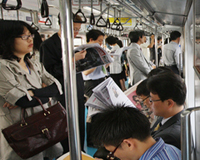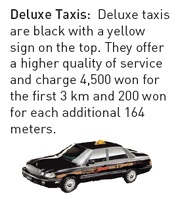Domestic flights: Most domestic destinations are within an hour's flight from Seoul. Gimpo Airport, located between the western area of Seoul and the newer Incheon International Airport, is primarily used for domestic travel and short flights to Japan and China. Korean Air, Asiana Airlines and a few domestic discount carriers handle all flights within the country.
Railway services: The Korea Railroad (KORAIL) operates three types of trains ― high-speed (KTX), express (Saemaeul), and local (Mugunhwa) ― along an extensive nationwide network. The KTX trains link Seoul with Busan, Mokpo, East Daegu, Gwangju and Iksan. Since even the longest KTX trip is under three hours, there are no dining cars, but passengers can purchase snacks and beverages from service carts provided.
Express trains usually have dining cars. Most popular destinations in the nation can be reached via direct line or a single transfer. Check Korea Rail's website (
www.korail.go.kr) for information about combination train-ferry tickets and rail passes available. (Note: Rail passes are only available to inbound tourists and must be purchased from certified Korail vendors overseas.)
Local and city bus services: Regular intercity and long-distance express bus networks connect virtually all cities and towns in the country. Regular intercity buses are the least expensive way to travel around the country but make frequent stops. Bus fares range from 700 to 1,800 won (US$0.74~$1.91). The website “
www.visitkorea.or.kr” has detailed information. Click on "Transportation."
Long distance express buses: Long distance express buses go directly to their destinations, stopping only at expressway rest areas every few hours. Two types of buses link every major city in the country. Regular intercity buses have four seats per row. The more-expensive deluxe buses have only three seats per row and offer amenities such as phones and movies. Some lines run late-night deluxe express buses as well. Seoul has three intercity terminals providing service to different parts of the country ― the main Express Bus Terminal and Nambu Bus Terminal on Subway Line 3 in Gangnam and the Dong (East) Seoul Bus Terminal near Gangbyeon Station on Line 2. Busan's Express Bus Terminal is in its eastern downtown area.
 Subway services:
Subway services: The subway is the most efficient and convenient way to get around Seoul, Busan, Daegu, Gwangju, Incheon and Daejeon. Subways have developed into these cities' main transportation systems and provide fast, safe, and comfortable rides. The Seoul Metro links all neighborhoods with the outlying areas and satellite cities. Fares vary according to destination, the basic fare being 1,000 won (US$ 1.06). Passengers can easily pay bus and subway fares and receive free transfers by using a debit card, known as T-money.
 Taxi services:
Taxi services: There are two kinds of taxis regular and deluxe. Fares are based on distance and time. The black deluxe taxis are more comfortable, provide better service and charge more than the regular gray taxis. Nearly all taxis are equipped with a free third-party interpretation system that can be accessed by cell phone if passenger and driver have difficulty communicating.
Car rental : Driving can be an exciting and effective way of getting around Korea. Extensive road and expressway networks are available, which means you can visit every corner of the country easily.
**Drivers must meet the following requirements:
-Have more than one year's driving experience.
-Have an International Driver's License.
-Be over 21 years of age.
-Possess a valid passport.
Rental fees vary from 68,000 to 265,000 won (US$ 71.5 - $ 278.9) per day, depending upon the type of car. The speed limit is 60km/hr for most roads in the city and 80-100km/hr on expressways. Driving under the influence of alcohol or drugs is a felony that may result in a heavy penalty.
Ferry services : One of the most pleasant ways to see Korea, popular mainland to island ferry routes are Busan to Jejudo, Mokpo to Hongdo, and Pohang to Ulleungdo. There are ships making runs between Busan and Yeosu, with many in-between stops possible at ports along the south coast and Hallyeo Maritime National Park. Click “Transportation” on the website
www.visitkorea.or.kr for more information about transportation and many other tourist-related information.

